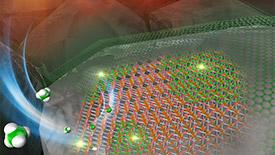

08/30/2021

Adapted from Ref. 1 with permission from the Royal Society of Chemistry.
An AIMR-led team has developed a scalable template-assisted method for fabricating edge-free, single-layer graphene mesosponge (GMS)1. Combining experiments with theory, the team has redesigned a known method using magnesium oxide (MgO) as template material instead of alumina (Al2O3). The use of MgO enables scalability and produces GMS with superior transport and mechanical properties compared with Al2O3.
Proof-of-concept experiments often need major redesign before they are scalable.
One such example is the recent template-assisted fabrication of an edge-free, single-layer GMS that can outperform carbon nanotubes as supercapacitor electrode materials2. While this method produces a robust GMS, the removal of its Al2O3 nanoparticle template requires the drastic use of hydrofluoric acid that prohibits its commercial application.
Here, scalability entails redesign of the fabrication method around a different template—one that can both form the desired GMS and be removed in a cost-effective way. The team selects MgO nanoparticles.
“MgO is a commonly used template material in commercial porous-carbon productions; it is easily dissolved by dilute acid solutions,” says Hirotomo Nishihara, the principal investigator from AIMR. “The trick is to make sure it can form GMS with the right features.”
To this end, the team has used a combined experimental/theoretical approach to elucidate the GMS-formation mechanism and to establish the optimal conditions conducive to desired features such as single-layer graphene walls.
In so doing, the team has determined not only that the graphene-sheet formation likely occurs at oxygen vacancy sites on stepped MgO(110) facets, but also that the formation of the first graphene layer is much faster than that of subsequently stacked layers. This latter finding enables fine control of the reaction time for obtaining single-layer GMS.
Direct property comparisons indicate that the GMS produced using MgO is not only a good supercapacitor electrode material, but it is also more mechanically flexible than the GMS produced using Al2O3.
“We are investigating the use of other metal oxides and their effects as template materials beyond MgO and Al2O3,” says Nishihara. “Ultimately, we are aiming for the development and the mass production of precisely controlled graphene nanomaterials.”
(Author: Patrick Han)
This research highlight has been approved by the authors of the original article and all information and data contained within has been provided by said authors.